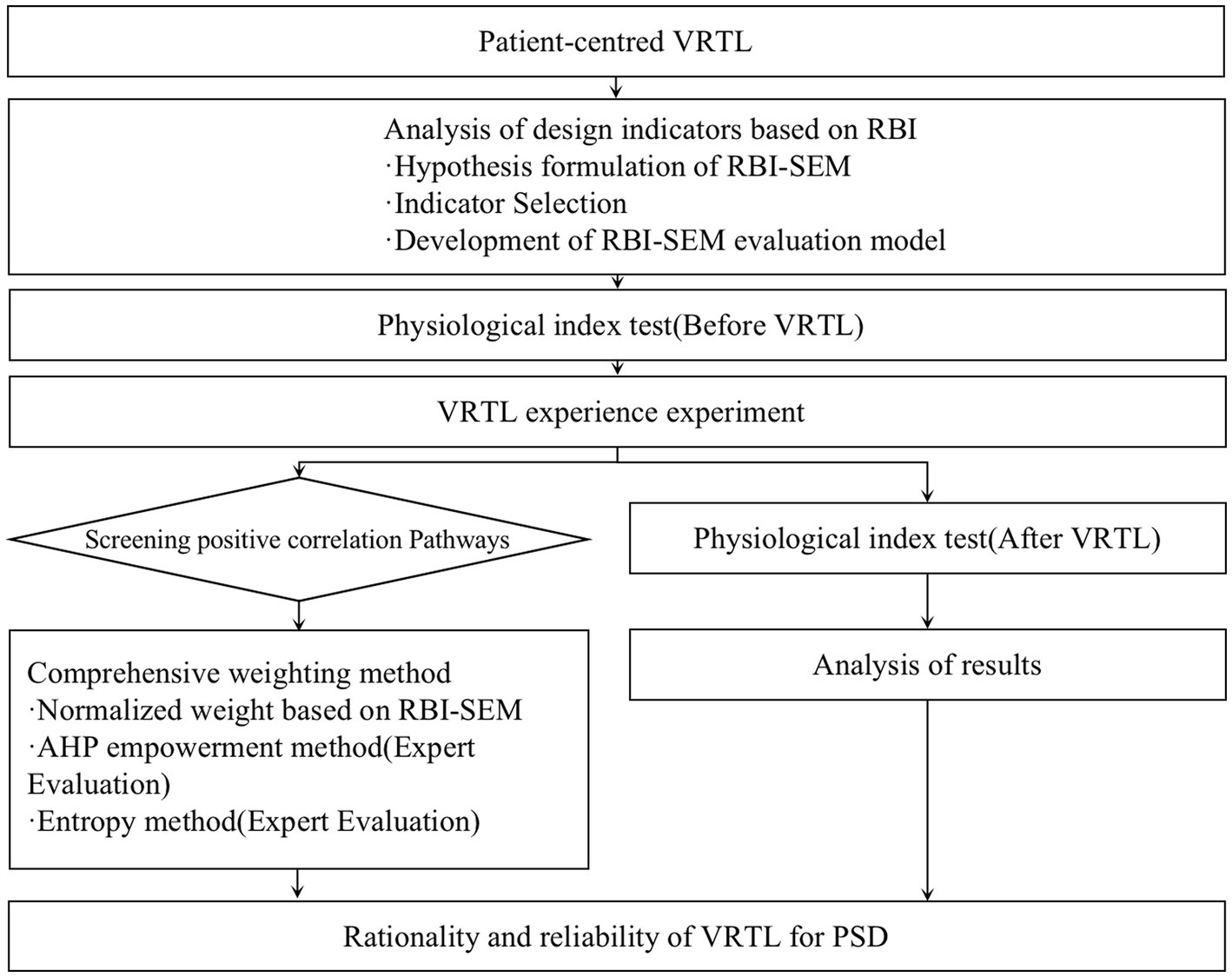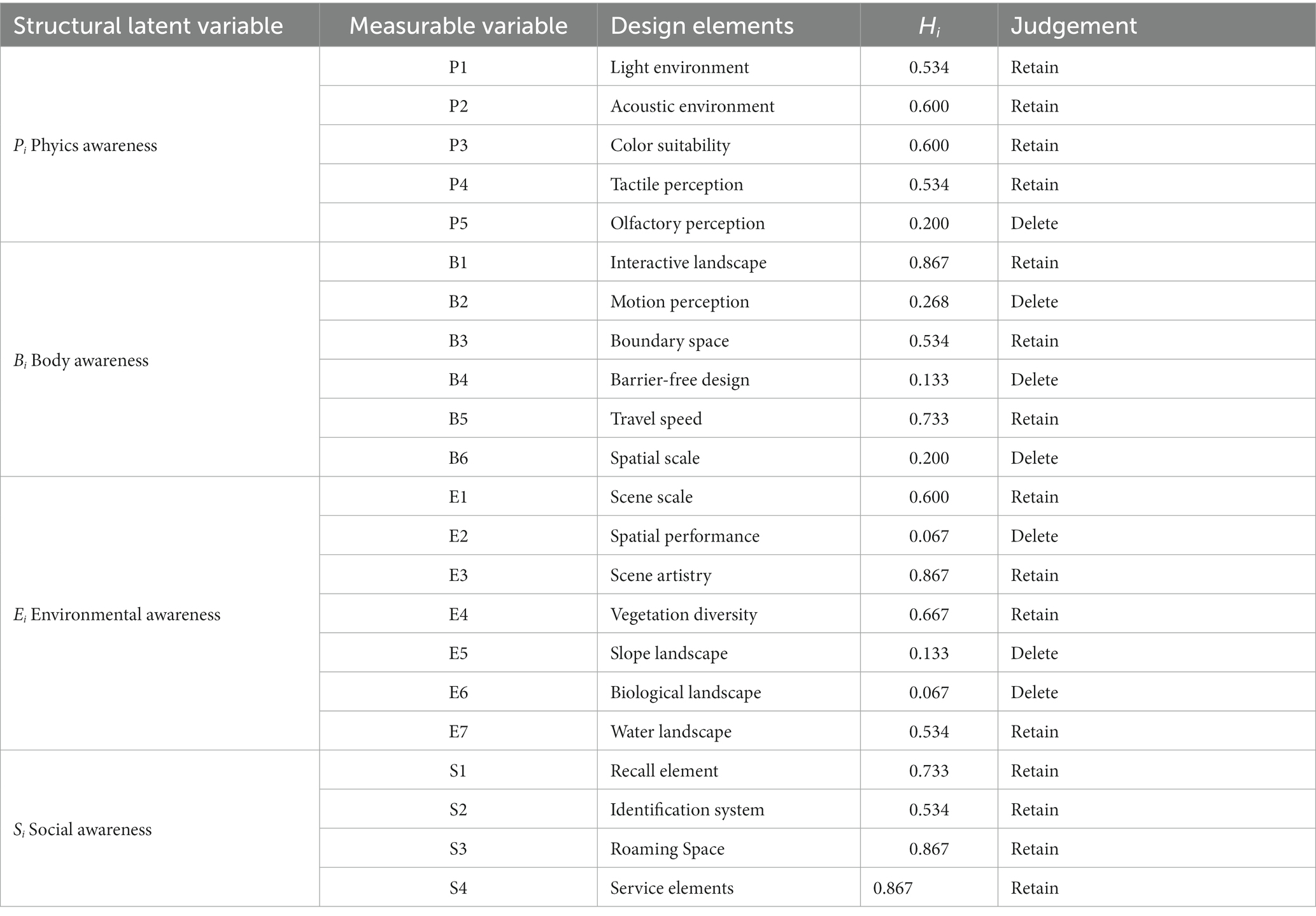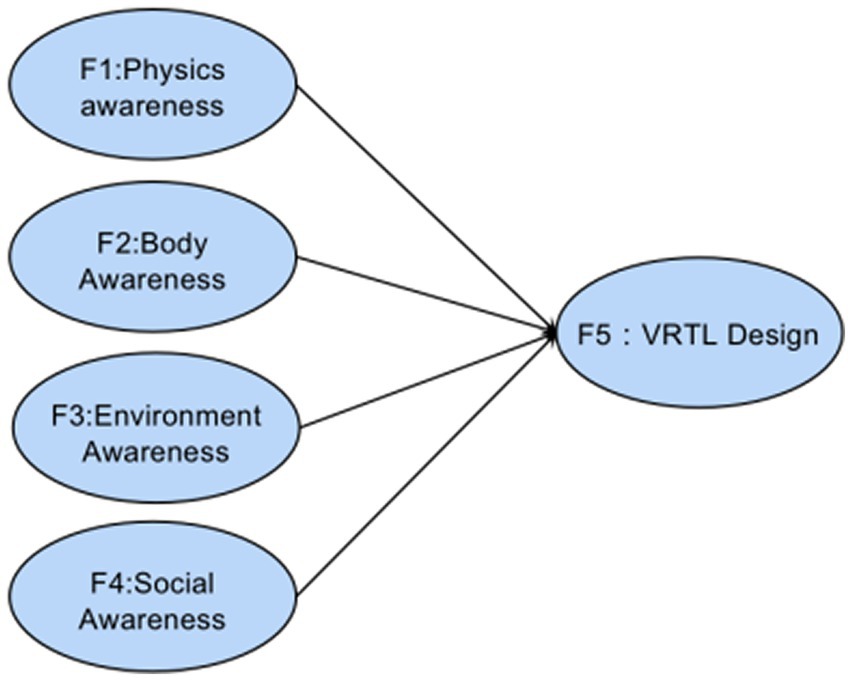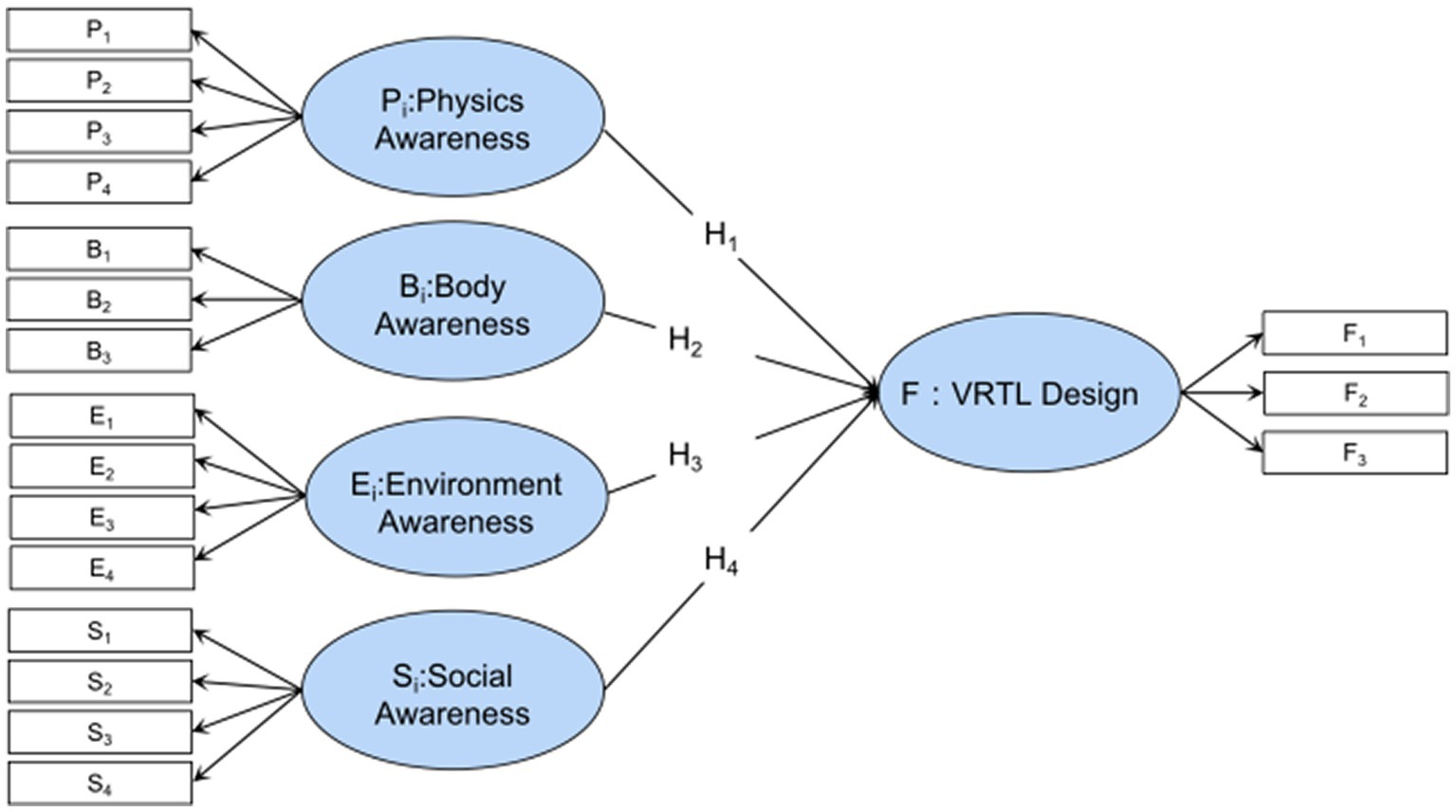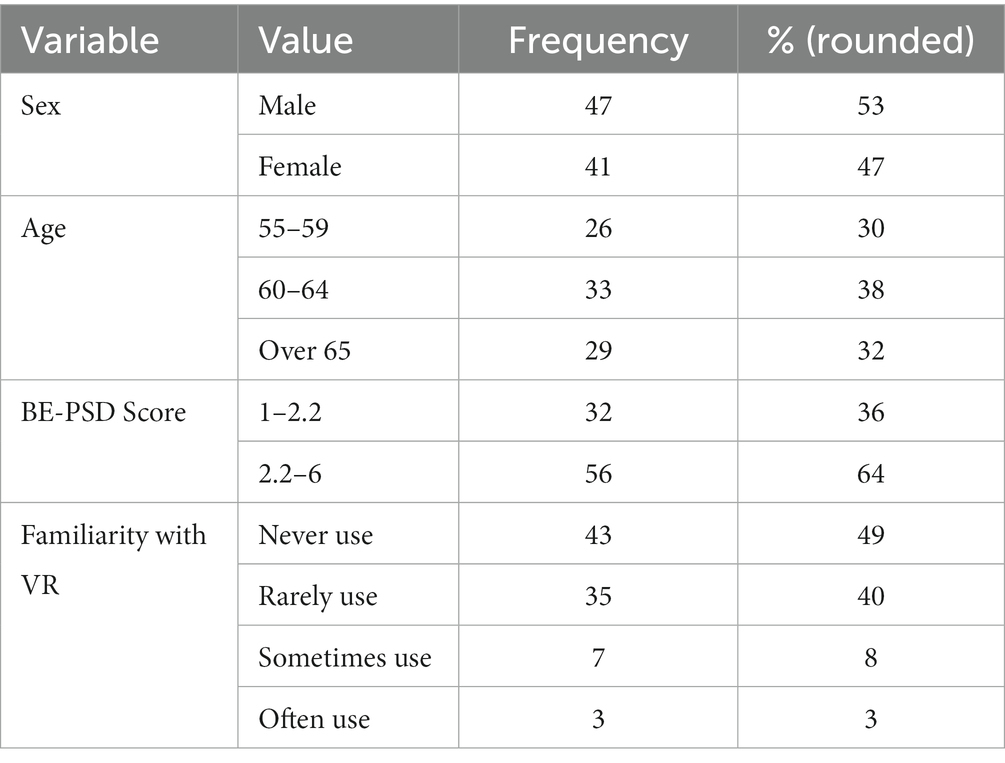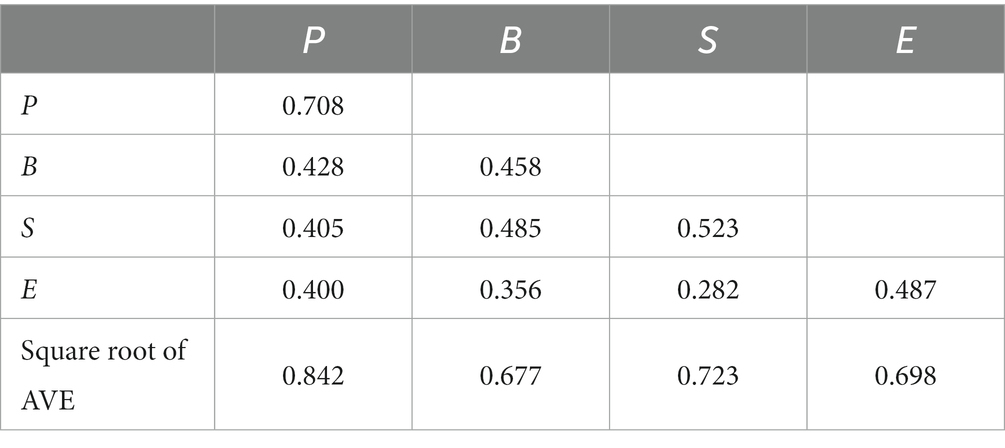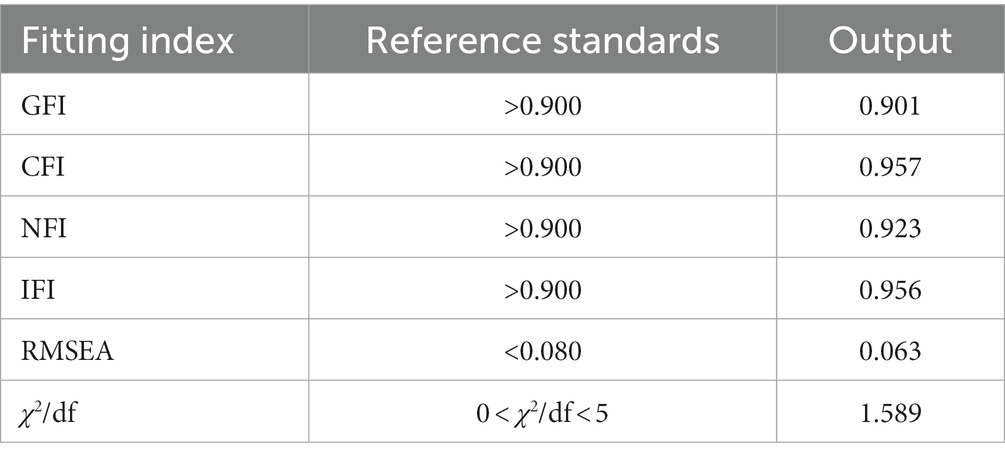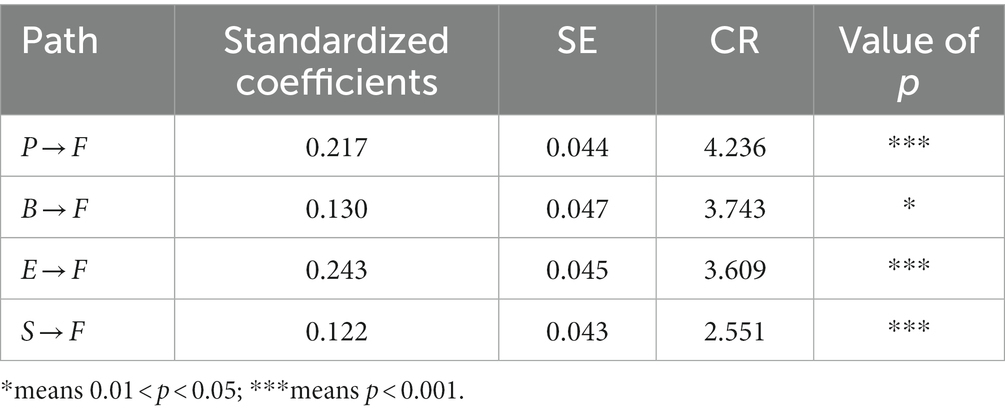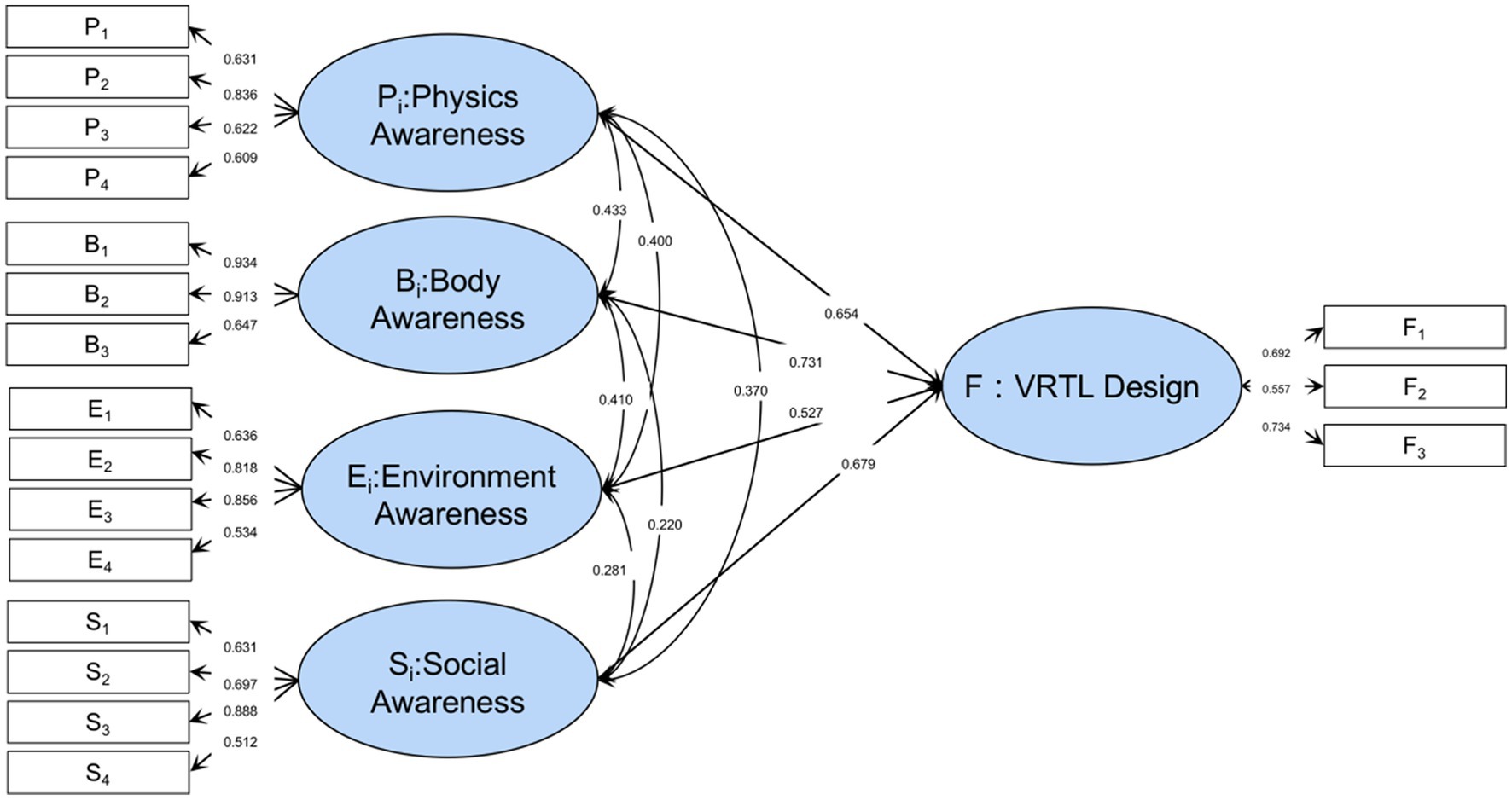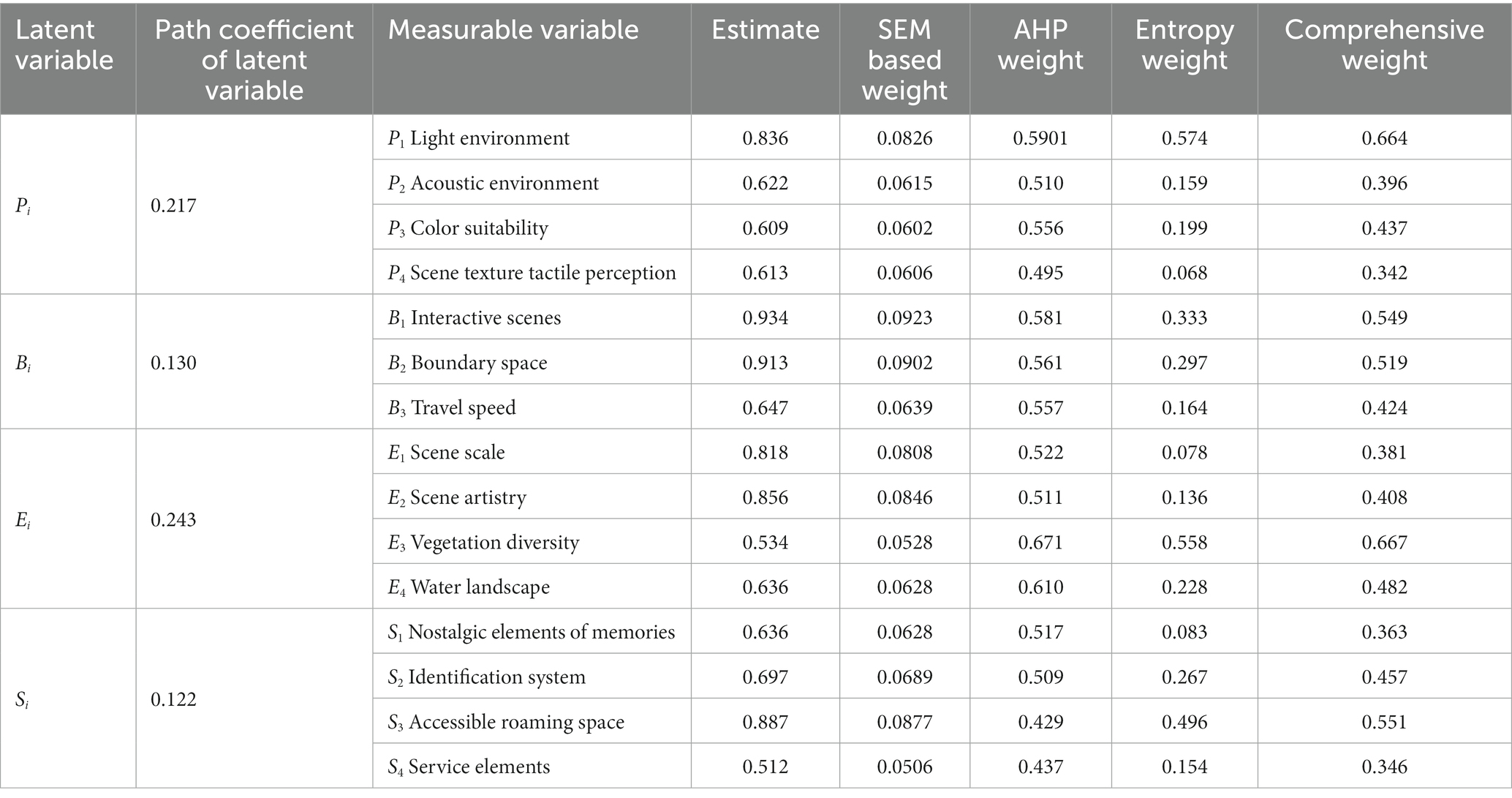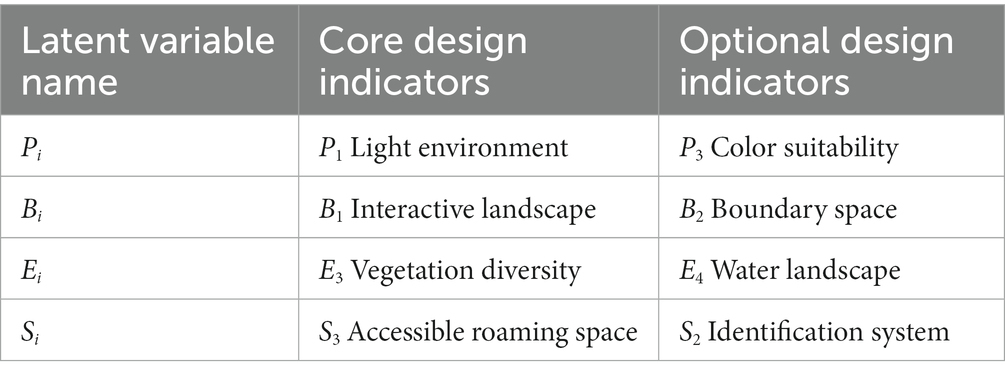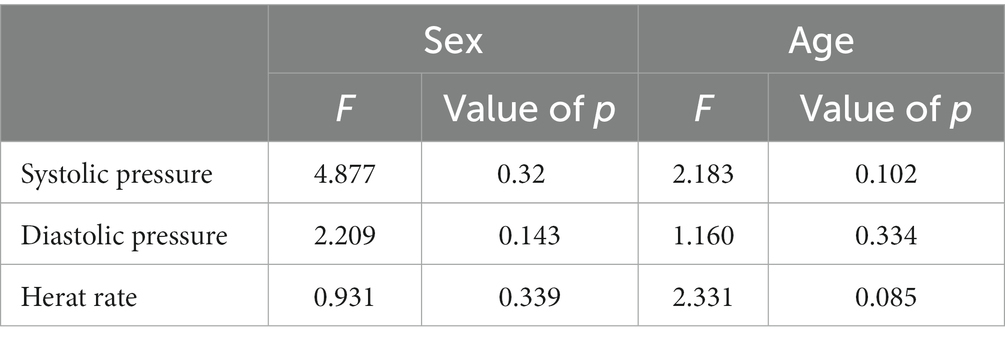- 1Department of Information Design, School of Design, Wuhan University of Technology, Hubei, China
- 2Department for Public Health, Wuhan Jinyintan Hospital, Wuhan, Hubei, China
Introduction: Since COVID-19, medical resources have been tight, making it inconvenient to go offline for the sequelae of diseases such as post-stroke depression (PSD) that require long-term follow-up. As a new digital therapy, VRTL began to gain popularity.
Method: The research is divided into two parts: pre-test and post-test. In the pre-test, an evaluation method integrating reality-based interaction (RBI), structural equation model (SEM), analytic hierarchy process (AHP), and entropy weight method is proposed. In the post-test the patients’ physiological indicators (Diastolic blood pressure, systolic blood pressure and heart rate) are measured to verify the effectiveness of RBI-SEM model using T-test method.
Results: In the pre-test, using SEM, it was confirmed that Pi physical awareness, Bi body awareness, Ei environmental awareness, and Si social awareness were significantly correlated and positively affected VRTL satisfaction (p >> F 0.217; B >> F 0.130; E >> F 0.243; S >> F 0.122). The comprehensive weight ranking based on RBI-SEM considered light environment (0.665), vegetation diversity (0.667), accessible roaming space (0.550) et al. relatively of importance. And T-tset in the post-test experiment considered that the data of the two measurements before and after the VRTL experience, systolic blood pressure (p < 0.01), diastolic blood pressure (p < 0.01), and blood pressure (p < 0.01) were significantly decreased; one-way ANOVA concluded that there was no significant difference in the changes of blood pressure and heart rate among participants of different ages and genders (p > 0.01).
Conclusion: This research validated the effectiveness of RBI theory for VRTL design guidelines, established an RBI-SEM based VRTL evaluation model, and the output VRTL for PSD in the older adults was confirmed to have significant therapeutic benefits. This lays the foundation for designers to decompose design tasks and integrate VRTL into traditional clinical treatment systems.
Contribution from the public or patients: Four public health department employees helped to improve the research’s content.
1. Introduction
Rehabilitative Landscape (TL) combines a specific natural environment, building environment, social conditions, and human perception to construct an atmosphere conducive to rehabilitation. TL is composed of Biophilia Hypothesis (BH) (1), and it has been proven through comparative experiments that the rehabilitation landscape can accelerate the recovery after the operation and reduce the use of drugs. In addition, TL plays an outstanding role in the treatment of psychological diseases. According to Psychologist Kaplan’s research, the natural landscape environment has a significant positive effect on the overall health of older adults, especially the enhancement of psychological satisfaction and pleasure, which can effectively combat psychological problems like depression (2).
In 2001, Marcus defined the outdoor environment as an “action space” in his research, analyzed the successful cases of rehabilitation environments in geriatric sanatoriums and hospitals, discussed the general layout of outdoor landscape environment design in geriatric residential areas, emphasized the importance of landscape rehabilitation function to the older adult residents, and proposed suggestions for the design of rehabilitation environment for the older adults (3). In addition, Zeisel et al. also covered numerous features of the rehabilitation landscape, and how they relate to Alzheimer’s disease and other mental diseases, including reducing physical and mental discomfort, improving quality of life, maintaining physical function, delaying aging, and extending residual cognitive ability (4).
The application of VR in medical industry began with the construction of simulated organs for surgical training. Rothbaum et al. (5). proposed Virtual Reality Therapy (VRT) to apply VR to the rehabilitation treatment of psychological diseases. At present, virtual exposure therapy (VRET) is widely used in VRT (6). and can effectively treat post-traumatic stress disorder (PTSD) by controlling and reproducing virtual exposure sources compared with live exposure. Combining VR technology with modern rehabilitation medicine, VRT shows advantages in many rehabilitation fields.
Virtual Reality Rehabilitation Landscape (VRTL) is an extended treatment approach to VRT (7). By simulating an immersive 3D virtual surroundings, characters and landscapes, patients can exercise in an immersive landscape to achieve therapeutic benefits (8). Through the VRTL for Parkinson’s disease patients, Klinger (7) found that if the patients were given a clear direction of action and an interactive landscape, rehabilitation training with VR could reduce the time users completed their actions in reality. Chandler (8) measured the heart rate and blood pressure of participants in various combinations of games and exercises, and the experiment demonstrated that there were no significant differences in physiological parameters between the VRTL and physical exercise groups. It is proven that VRTL has an exercise effect and can promote health. Similarly, with the maturity of technology, VRTL has been applied to more and more fields of disease rehabilitation, including improving the cognitive level of stroke patients (9), treating Parkinson’s (10), overcoming psychological trauma (11), and rehabilitating limbs and balanced perception (12).
Robert J put forward reality-based interaction (RBI), pointing out that the interaction of the virtual world is the simulation of the objective world (13). At the beginning of the theory, RBI was mainly used as an evaluation tool to improve the user interface (UI) for the VR environment. Adamides et al. applied RBI to the design of a remote control system for agricultural machinery (14). Similarly In order to demonstrate the viability of RBI as a design guiding tool, Tairan Li et al. (15) proposed the design theory of the space-three-dimensional object-menu-interactive approach (SOMM) in VR. They then utilized it in industrial assembly training. Researchers have discovered that RBI is applicable to other design processes besides UI design since RBI is being used in more and more design practices. Using four criteria based on RBI, Audrey et al. (16) further interpreted user interaction behavior: Pi physical awareness, Bi body awareness, Ei environmental awareness, and Si social awareness. Pi denotes the basic spatial components and sensory indicators in VRTL; Bi denotes the interactive functions and actions that can be realized in VRTL; Ei denotes the landscape element in VRTL and is a concrete representation of landscape healing, similar to, e.g., Li et al. (17). Using sound, location, and weather as measured variables of the environment in their study, combining them with daily activities and physiological information, it was concluded that they could respond to changes in the self-perception of the subject through long-term recording; Si denotes the achievable social content and emotional elements in VRTL (18), and it is worth noting that the sense of direction is greatly diminished in immersive VR, thus guiding elements such as haptics are may necessary (19). Additionally, some scholars have summarized the theoretical framework of interaction methods from special technology or environment (20). They proposed theoretical models based on qualitative data, such as mind-flow based interaction, gesture recognition oriented interaction, and multi-angle interaction.
The above research shows that the application of RBI and VRTL in rehabilitation medicine is expanding continuously. However, there is a dearth of research on how to construct VRTL. So, the VRTL design at this point lacks examination and analysis of patients’ demands and is primarily focused on conventional therapies or designed solely based on the developer’s subjective experience (18, 20). Therefore, it is urgent to construct a VRTL design process centered on patient experience and explore a reasonable method for evaluating design elements. In traditional user needs analysis, the subjective evaluation method hierarchy analysis (AHP) is widely used, which can effectively reflect expert opinions and quantify the indicators. Constant and entropic weighting is used in combination due to an overreliance on objective weighting methods such as subjective opinions (21). The structural equation model (SEM),widely used in the field of user experience, comprehensively evaluates the constructed model and verifies its rationality by using various statistical methods (21). Unlike traditional evaluation methods, SEM can estimate the relationship between multiple potential variables, retain and remove measurable variables with weak correlation, and is suitable for VRTL design based on RBI theory.
In general, this paper presents two research questions. Firstly, the RBI-SEM model is proposed, hypothesizing that Pi physical awareness, Bi body awareness, Ei environmental awareness, and Si social awareness are significant correlation to VRTL, and patient evaluation scales are collected through VRTL experiment to verify the theoretical. In addition, the RBI-SEM path coefficients were integrated with AHP and entropy weight method to rank the design indicators (later referred to as pre-test). Secondly, physiological indicators (including heart rate, systolic blood pressure, and diastolic blood pressure, later referred to as post-test) were collected from patients before and after the VRTL experience experiment to verify the therapeutic effectiveness of VRTL on PSD, to provide empirical research support for the design conception, and to further validate the feasibility of the design methodology.
2. Methodology and research processes
2.1. Research processes
Traditional weighting methods are based on the subjective experience of researchers and have limitations. Therefore, this study precedes the assumptions made by SEM, which is widely used in multithreaded planning, to validate the validity of the model by collecting patient experience data according to the test software. After evaluating and calculating each algorithm based on RBI-SEM, the weights are linearly combined and sorted to guide the design practice. Specific steps are as follows in Figure 1. There are three main steps to the research process:
Step 1: Assumptions proposed and RBI-SEM model established. SEM model is proposed based on RBI theory and all potential variables are assumed to contribute positively to VRTL design; In the case study, VRTL test software is run to collect evaluation data of each measurable variable from patients to confirm the model’s validity.
Step 2: Comprehensive evaluation model for VRTL. Based on the SEM path coefficient, the design index is comprehensively evaluated by linear synthesis using the normalization algorithm, subjective weighting method AHP and objective weighting method Entropy Weighting method.
Step 3: Measurement of physiological indicators. After the patients have experienced the VRTL, the validity of VRTL design is verified by measuring physiological indicators such as blood pressure and heart rate, and compared with the effect of traditional rehabilitation therapy.
2.2. Introduction to the scale used
During the process of this research, it was necessary to collect patient or expert opinions through various scales multiple times. Questionnaires were needed in Pre-test for screening PSD patients, screening VRTL evaluation indicators, and evaluating the VRTL experience. Accordingly, a 7-point Likert scale was used throughout the study, with higher values representing greater satisfaction or agreement. The details are as follows:
1. BE-PSD scale: This scale was used to screen patients with PSD from stroke patients to experience VRTL. Based on the results of Takeuchi et al. (22), the present research rated the symptoms from mild to severe with a mean value >2.2 on several dimensions such as mental status, thought disorder, and negative condition to determine poor mental well-being. Additionally, Everton et al. (23) found that complications such as vomiting caused by stroke are also likely to cause depression, so physical condition was added to the scale as an additional evaluation dimension.
2. RBI-SEM indicator screening scale: This scale was used to screen indicators that comprise the theoretical model from a larger number of VRTL indicators. Structural equation modeling was used in the study to argue whether Pi, Bi, Ei, and Si in RBI theory were significantly correlated with VRTL, while more theoretical approaches emerged in the literature studies, which were screened by expert scoring.
3. RBI-PRS scale: Perceived Restorativeness Scale (PRS) was proposed by Hartig et al. (24)to evaluate the restorativeness of the environment from being away, fascination, cooperation, compatibility, four dimensions. This scale has been widely used in landscape restoration evaluation (25, 26). The questionnaire is the most important information collection tool for RBI-SEM, and the scale was used to collect evaluation information after VRTL experience to provide data for the validation of RBI-SEM model and index evaluation. Also, The scores of negative questions were being revised for consistency.
3. Theoretical modeling and analysis
3.1. Indicator screening
In VRTL, the software simulates how patients view, analyze, and engage with landscapes, mostly using their five senses. Patients also receive treatment using these procedures. Various factors will affect the final cognitive outcomes during the recognition process. Generally, there are two types of influencing factors: subjective influences (from the cognitive subject) and objective factors (from the cognitive object). Different types of users have different needs for the rehabilitation landscape, and there are also variances in the performance of restrictive factors of different geographical characteristics. Therefore, it is necessary to specify a set of elements evaluation index system and establish the weights of each index factor. Six fundamental principles—scientific, methodical, integrated, purposeful, practical, and operable—will be closely followed in the establishment of the hierarchical structure of the virtual rehabilitation landscape evaluation. The reliability and validity of the evaluation outcomes are, in part, determined by these principles, which also play a guiding role in developing an acceptable evaluation index system and a scientific evaluation model.
Based on the above literature and related research, the optional VRTL design methods are concluded for selection by professionals through RBI theory and existing VR technology capabilities (12). In formula (1), 15 relevant experts advise that H is the correlation of this index to VRTL design, G is the number of experts who choose this index, N is the number of valid questionnaires received, and H is <0.5, then this index is not suitable for VRTL design. As shown in Table 1, it summarized and classify the common and major influencing factors in VRTL for older adults with depressive tendencies. According to RBI, the elements of evaluation are classified as physical perception, action perception, environmental perception and social perception. According to the above four categories, 13 rehabilitation elements related to research concepts are selected as measurable variables.
3.2. Theoretical model construction
Traditional factor analysis struggles with models that have complex subordination relationships, such as one index subordinating to multiple factors or considering higher-order factors, but structural equation analysis allows for more complex models. Traditional path analysis only estimates each path’s strengths (relationship between variables). In structural equation analysis, different models can be calculated to fit the same sample data as a whole to determine which model is closest to the relationship presented by the data, in addition to the above parameter estimates. Meanwhile, the design elements of VRTL are interrelated according to RBI design theory, so the rationality of the index system corresponding to each potential variable cannot be analyzed and the weight coefficient can be determined separately. Hence, the basic model in Figure 2 is built on the four dimensions of RBI theory. The RBI-SEM model was constructed from the measurable variables in Table 1, as shown in Figure 3, assuming that the four RBI-based latent variables P, B, E, S are significantly correlated with and providing positive effects on VRTL design satisfaction.
3.3. Model calculation method
3.3.1. Weighting algorithm based on the coefficient of action path
Before calculating the weight of SEM, a measurement model is as shown in Figure 3, and the relationship between the measurable variable and the latent variable is as follows. Where X denotes the external indicator; Y represents an endogenous indicator; _x stands for the embodiment of exogenous index X and exogenous potential variable ξ Relationship; _y is an endogenous indicator Y and an endogenous potential variable η Links; δ, ε denotes the Measurement errors for X and Y, respectively.
The path equation, which reflects the correlation between the underlying variables, is described as follows:
where ni:p × 1 Vector of the number of observed endogenous variables. Xi:q × 1 Vector of the number of observed exogenous variables. α: P × 1 Vector of the intercept of the regression equation. Β: P × P Matrix of the slope of the regression equation. P × The matrix of the slope of the Q regression equation. Ζ: P × 1 Disturbance factor is the vector of residuals.
According to (2)-(4) the action path coefficient value (i.e., factor load, the larger the value, the greater the influence of the measurable variable on the latent variable. In the SEM model of VRTL, the degree to which the design element can provide user satisfaction) can be obtained. The normalization algorithm is used to get the index weight as follows:
Formula: physical perception, action perception, environmental perception and social perception are, respectively, the function path coefficients of the first indicator; Wxi is the first index weighting value I = 1, 2,…, 13 for physical perception, action perception, environmental perception and social perception, respectively.
3.3.2. Comprehensive empowerment
The subjective weighting method AHP is widely used in various index evaluations. The common methods for calculating the weighting vector include the how-average method, arithmetic average method and feature vector method (27). Three methods are applied in this paper to calculate the index of conceptual design according to the assignment of experts. and the average value is taken as the final subjective weight to ensure the accuracy of the assignment. The detailed procedures are as follows:
Step 1: Assume that the judgment matrix is
Step 2: Obtain the subjective weight vector
When constructing the judgment matrix, we rely on expert scores to get quantitative data. Because of the unilateral subjectivity of experts’ perceptions, it is difficult to ensure the existence of errors, which leads to contradictions in the information of the judgment matrix and affects credibility. Therefore, consistency testing of the constructed judgment matrix ensures the effectiveness of subjective decisions. Represent consistency metrics as , Where the maximum eigenvalue is represented as , stands for the order. In practical applications, a consistency check should be carried out before weight calculation. The specific formulas are as follows:
AHP can effectively assign subjective weight to design indexes, but experts are prone to make misjudgments and misjudgments due to their mental burden when confronting high-order matrices. To solve the subjective misjudgment caused by experts, the objective evaluation method is introduced to correct the index elements, which can effectively reduce subjectivity in problem (27). The entropy method, as an objective evaluation method, gives the objective weight of index based on the information Entropy, and information Entropy represents the measurement of the uncertainty of random variables in a system, or the uncertain impact of indicators on the final results in the evaluation system (with uncertain weights). The smaller the indicator, the greater the difference between the representative and other indicators. The more information provided and the greater the weight. The specific calculation method is as follows:
Step 1: Construct the decision matrix and standardize it. Assuming there are m elements and N expert decision scoring, the evaluation decision matrix is:
Step 2: Calculate the normalized matrix and form the normalized matrix by the ratio of column vectors. The sum of all elements is in the normalized matrix . The calculation process is as follows:
where Step 3: Calculate the information Entropy of the index based on the normalization matrix Information Entropy of Index J is obtained by using Formula (13) .
where K is the adjustment coefficient, K = 1/lnn.
Step 4: Determine the objective weight of the index. According to the information Entropy, the weight of index J is obtained by formula (10).
Step 5: RBI-SEM design method and subjective and objective weights are used to modify each other and get comprehensive weights of indicators. In this research, the weights based on SEM are equally important as subjective and objective weights. The formula for calculating the comprehensive weights is as follows:
4. Design practice
4.1. Population and sample
Stroke is one of the commonly occurring acute cerebrovascular diseases in the older adults and, in addition to physical damage, it can have serious psychological and emotional consequences (21, 22). And the most frequently seen psychiatric problem is post-stroke depression (PSD). Centered on the characteristics of PSD patients, this study focuses on acute stroke patients who were hospitalized in the Department of Neurology at JinYintan Hospital, Wuhan City, Hubei Province, from March 2021 to August 2021. Data are collected the patients hospitalized for stroke for at least 3 days. If the patient has recently undergone surgery, the attending physician’s recommendation will be taken into account and the patient will be selected as having a relatively stable condition. All final samples satisfy the following conditions: age above 55; clear awareness; good reading ability, no cognitive and communication barriers; stroke diagnosed by a head CT or MRI. The basic information of the patient participants is shown in Table 2.
4.2. Pre-test task definition
The purpose of Pre-test is to evaluate the importance of each design element in VRTL to construct and validate the RBI-SEM evaluation model for Post-test. The Oculus Rift + Touch system was used as the interaction hardware in the test procedure, and the test screen of the VRTL is shown in Figure 4. In this highly immersive VRTL testing procedure, patients can switch between motion and first person perspective.
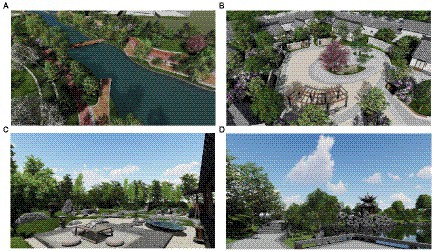
Figure 4. (A) Preview of the overall environment with mainly natural landscape (the first minute). (B) Preview of the overall environment with mainly humanistic architecture (the first minute). (C) Interactive landscape, drinking tea. (D) Roaming space and sculpture and other landscape displays.
After a 5-min VRTL experience (1 min overall preview, 4 min self-guided tour). A total of 88 patients participated in the experiment, and after a 5-min VRTL experience (1-min overall preview and 4-min self-guided tour), patients evaluated the importance of the design indicators in order according to the four dimensions in the RBI-PRS scale (each indicator consisted of four dimensional scores, and the mean was taken as the final assessment). Considering the complexity of VRTL evaluation, 10 graduate medical students and 5 university faculty members were invited to be responsible for AHP evaluation and entropy weighting evaluation, respectively, and lastly, patient evaluation and expert evaluation were linearly integrated.
4.3. Model measurement and discussion
4.3.1. Model measurement
Reliability and validity tests should be conducted prior to quantitative analysis to ensure the validity of the classification of potential variables in the model. The SPSS software is used for reliability tests. The study used Cronbach’s α to measure the reliability of the data, when the reliability coefficient is >0.8 indicates good reliability, 0.6–0.8 indicates acceptable reliability, when below 0.6 indicates poor reliability requires rearrangement of the variables in the RBI-SEM model. After testing, Cronbach’s α of Pi, the minimum value, maximum value and average value are 0.807, 0.853, and 0.821 respectively; for Bi are 0.702, 0.818, and 0.754 respectively; for Ei are 0.816, 0.865, 0.852 respectively; for Si are 0.812, 0.868, and 0.789, respectively. Overall, the data are highly accurate, complete and reliable. The calculation results are shown in Table 3.
Secondly, SPSS software is used to test the validity, which includes content validity, criterion validity and structure validity. Generally, content validity and construct validity are tested.
Moreover, because the good integrity of the statistical data, they are all evaluated after the VRTL test. The structure validity refers to the correspondence between a certain structure and the measured value reflected by the measurement results. The KMO and Bartlett sphericity of factor analysis method in SPSS software are commonly used for the structure validity test. When KMO is >0. 8, it is considered that the effect is good, 0.7–0.8 is fair enough, 0.6–0.7 is unacceptable, and the indicators should be re-selected when KMO is below 0.5. The test shows that the minimum KMO of P is 0.707, the maximum is 0.803, and the average is 0.718; B The minimum KMO of each explicit variable is 0.742, the maximum is 0.867, and the average value is 0.829; The minimum KMO of E explicit variable is 0.793, the maximum is 0.848, and the average value is 0.835; The minimum KMO of each explicit variable is 0.709, the maximum is 0.768, and the average is 0.793.The results are shown in Table 4.
Table 5 shows that the goodness of fit index GFI, comparative fit index CFI. According to the table, the normative fit index NFI and value-added fit index IFI of the model are all >0.900, and the results are well matched. The root mean square of approximation error (RMSAE) equals 0.063, which is <0.080, and the results fit well. Chi square degree of freedom ratio χ2/df = 1.589 < 5. In conclusion, the overall convergence validity of VRTL model is good. The factor loads of the observed variables, which correspond to the four potential variables (physical perception, action perception, environmental perception and social perception) in the model, are all >0.5. It indicates that the corresponding observed variables are representative. The AVE of the mean variance variation corresponding to each dimension is >0.5000, and the combined reliability CR is >0.800, indicating that the convergence validity is ideal. Secondly, we verify the model discrimination validity. The obtained absolute values of the correlation coefficients of the five latent variables are <0.500 and are less than the square root of the corresponding AVE. The latent variables have a certain degree of discrimination, which means that the scale data have good discriminant validity.
4.3.2. Result of RBI-SEM model
In the previous step, we have finished measuring the RBI-SEM model and confirmed its strong convergence and discrimination validity. Table 6 displays the model standardization coefficient. The theoretical model’s latent variables are thought to positively affect the VRTL design, indicating that design optimization in these four areas can also benefit the VRTL design. The final RBI-SEM model results are shown in Figure 5. The Standardized path coefficients of the other measured variables can be seen in Table 7.
4.3.3. Integrated weighting calculation
SEM calculation shows that each potential variable has a positive effect on VRTL design satisfaction. The next step is to rank the indicators of each measurable variable. However, the action path coefficient cannot directly reflect the weight of measurable variables or guide design practice. By constructing a normalized algorithm for path coefficients, combining traditional subjective and objective comprehensive weighting methods, and fully balancing subjective and objective weights, a statistical table of RBI-SEM design elements based on multiple weighting methods is obtained, as shown in Table 7. where, based on the standardized path coefficient in the SEM model, the weight index of each measurable variable based on SEM is obtained by using Equations (2)-(5), as shown in columns 4 and 5 of Table 7; Based on the subjective weighting method AHP, the subjective weight index of each measurable variable is gained by using Equations (6)-(9), as shown in the column 6 of Table 7; Based on entropy weight method, the objective weight are gotten by using Equations (10)-(14), as shown in the column 7 of Table 7; Finally, according to Equation (15), the weights are linearly combined to obtain a rational importance ranking of design indicators, which can be used to guide the VRTL design, as shown in the column 8 of Table 7.
4.3.4. Pre-test evaluation results
VRTL can address the landscape requirements of older adults with depressive tendencies and provide positive psychological and physical interventions, while also being able to reduce the medical burden and provide intelligent strategies for a variety of chronic conditions (28), and its currently an effective aid in preventing and combating depression (10, 29). A summary of the VRTL design elements recommended for use in PSD is shown in Table 8.
Our results concluded that RBI-SEM verifies Pi physical awareness, Bi body awareness, Ei environmental awareness, and Si social awareness significantly correlates with VRTL design (P >> F 0.217; B >> F 0.130; E >> F 0.243; S >> F 0.122).For the latent variables the importance ranking is Ei (p < 0.001), Pi (p < 0.001), Si (p < 0.001), Bi (p < 0.05). It indicates that the environmental ambience and landscape in the virtual environment are most essential, and it is the most notable difference between VRTL and physical treatment approaches. In the construction of VRTL, from the perspective of comprehensive consideration, more emphasis should be placed on highly immersive landscape display methods such as panoramic scenes in VR to make full use of the sensory stimulation brought about by virtual technology, thus maximizing the effectiveness of VR-based rehabilitation elements (e.g., the drinking terrace, sculpture, and flower bed in the VRTL experiment). Secondly, patients also consider the physical perception element relatively important after the experience, which indicates that it is necessary to provide basic behavioral simulation in VR, and that multi-sensory interaction is more conducive to immersive VRTL experiences.
In the ranking of latent variables, importance can be roughly ranked according to the magnitude of the standardized path coefficients (e.g., Bi body awareness is already lower in correlation coefficients), while secondary indicators continue to proceed with AHP and entropy evaluation according to the RBI-SEM model. In environmental awareness (0.243). the B comprehensive evaluation weight (0.667) is the highest among the measured variables, indicating that the vegetation scene in VRTL can maximize user satisfaction, and the vegetation in VR is not only an important carrier of color but also the main form of space, and the overall style of natural vegetation is recognized by patients, while the AHP weight (0.671) and entropy weighting method (0.558) were both higher and consistent. The overall evaluation weighting of B (0.482) ranked second, indicating that a highly restored hydrological landscape can provide a better healing atmosphere, and combined with the vegetation landscape, most patients in this study tended to use the VR system to experience the natural landscape. In contrast, patients’ demand for evaluation of human landscape and landscape artistry was weaker, which may be due to the poor reproduction of various details of human art by existing VR devices and modeling methods, resulting in the inability of this element to attract the attention of the subjects.
Moreover, the physical awareness (0.217) was relatively important, but combined with its AHP and entropy weight evaluation, the importance was lower than Ei. The comprehensive importance order of the measurable variables was light environment (0.664) > color suitability (0.437) > sound environment (0.396) > scene texture band option (0.342). The evaluation results show that the visual environment and visual color in VRTL are the priority of users’ interests, and the design of the VRTL test software, which focuses on outdoor illumination and natural color restoration, is accepted by PSD patients. However, the evaluation of the auditory environment was relatively low, which may be due to the generally older age of the sample in this study, the relatively poor auditory ability, and the lack of auditory equipment for the VR environment, so the auditory reproduction was poor and did not provide satisfactory outcomes.
Social awareness (0.122) was significantly associated with VRTL design, but its path coefficient was relatively low. The order of importance of its measurable variables is: accessible roaming space (0.551) > identification system (0.457) > nominal elements of memory (0.363) > service elements (0.346), indicating that in the construction of social perception of VRTL, the spatial boundary restrictions and scale space changes should be fully utilized, which can realize the multi-level display of space, create easy to perceive and roam spatial forms that enhances the interaction and immersion of older adult people with depressive tendencies.
Lastly, body awareness (0.130) was significantly correlated with VRTL, but the path and correlation coefficients were both low, and the importance ranking of the measurable variables was interactive scenes (0.549) > boundary space (0.519) > travel speed (0.414). The SEM results showed low importance. However, the combined evaluation weight of interactive landscape in the group (AHP: 0.58; entropy weight: 0.33; combined: 0.55) is the highest among the potential variables, indicating that the interactive landscape in VRTL is considered to be able to satisfy the VRTL treatment to the maximum extent in the expert evaluation. In the subsequent design, the tactile feedback of natural landscape and the addition of treatment-related flora and fauna images can be designed to enrich the means of interaction in VRTL.
4.4. Post-test
4.4.1. Effect of VRTL on physiology of subjects and correlation analysis
The physiological data before VRTL treatment is used as the physiological index in the hospital environment, while the physiological data after VRTL treatment serves as the post-test data, by evaluating the differences between the changes in patients’ physiological response values in the hospital environment and after VRTL treatment.
Before and after participating in the virtual rehabilitation environment experience, older adults with depression tendencies have their diastolic blood pressure, systolic blood pressure, and heart rates compared. The outcomes are displayed in Figure 6. The extent and frequency of their drop and growth are similar before and after the virtual rehabilitation landscape experience, yet there is a shift in the total statistics. Systolic and diastolic blood pressure decreases are larger than increases with a similar frequency of occurrence, showing a general downward tendency. The heart rate of patients with depression tendencies has been greatly decreased through the virtual rehabilitation landscape experience, as shown by the fact that the decrease in heart rate is significantly greater than the increase in heart rate in degree and frequency.
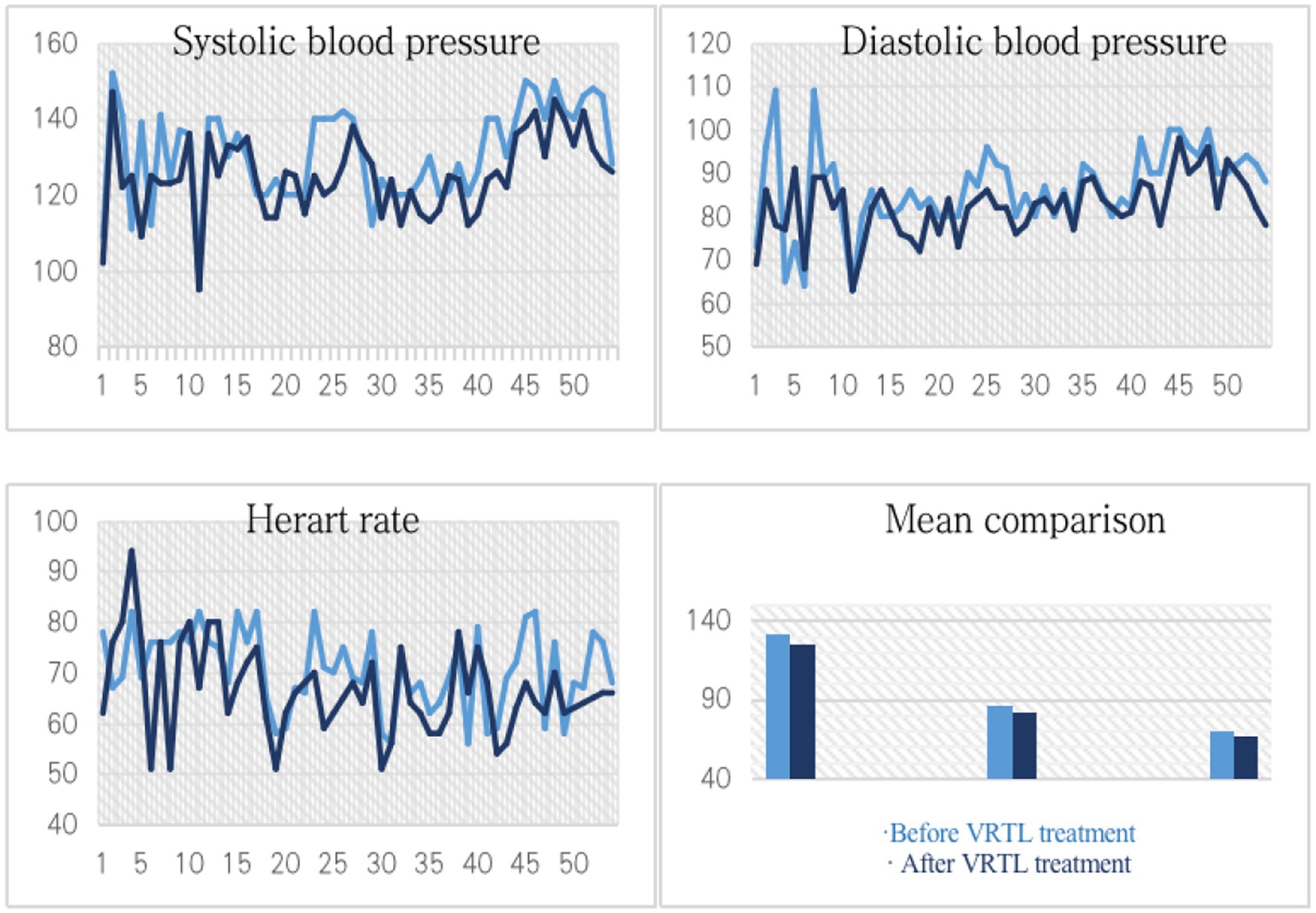
Figure 6. Changes of blood pressure, heart rate and their mean values before and after VRTL treatment.
It is possible to find whether there is a significant difference between the mean value of pre-test data and the test value of post-test data based on the T-test analysis results of paired samples of pre-test and post-test data provided in Table 9. The results show that the statistical T values are all normal distribution, and p-values are all <0.01. Therefore, the mean blood pressure and heart rate after the assessment are significantly different from those before the assessment. Combined with the changing trend, it can be considered that the virtual rehabilitation landscape experience has a positive impact on the physiological health of older adults with depression tendencies and can effectively reduce human blood pressure and heart rate.
4.4.2. Relevant factors affecting physiological rehabilitation effect
When compared to the pre-test, the systolic and diastolic blood pressure of the older adult with depression tendencies reduce to a certain level after experiencing VRTL, according to the study. It suggests that VRTL positively impacts older adults’ physical health. The post-test blood pressure and heart rate data of older persons with depressive tendencies are evaluated by one-way ANOVA with gender and age to determine the relationship between the fundamental characteristics of the comparative sample and the physiological data. According to the results of the correlation analysis in Table 10, p-value > 0.01, it can be considered that there is no significant difference in the changes in blood pressure and heart rate among the subjects of different ages and genders.
By comparing the correlation between physiological data and the virtual rehabilitation landscape factor evaluation system, the bivariate equation of simple regression and the multivariate linear regression equation are performed for the reduction of post-measured diastolic blood pressure, systolic blood pressure and heart rate with the results shown in Table 11. It can be seen from the coefficient of the equation that scene scale and scene art in VRTL have a positive impact on systolic blood pressure, while scene art benefits diastolic blood pressure, and the reduction of the heart rate of vegetation diversity and water landscape also has a positive impact.
The data shows that the positive effect of VRTL on the blood pressure of older adults with depression tendencies is mainly due to the setting of TL. Also, the immersive qualities and other features provided to users by VR technology, such as interactive richness and landscape aesthetics, form a notable contrast with the real landscape space. The former can make PSD patients who experience virtual scenes more relaxed physically and mentally. Their heart rate is also positively affected by the virtual landscape elements, especially the water landscape, which shows that a reasonable hydrological landscape layout can help depressed older adults release pressure and calm their emotions.
4.5. Strengths and limitations
In our research, the RBI-SEM evaluation model was established and quantitatively should confirm the significant correlation of P, B, E, S on VRTL in RBI theory, which can guide the design practice in more detail than the conventional structural equation and regression analysis studies. And in the post-test, it was concluded that the changes in physiological indicators were significant, and the VRTL utility was empirically analyzed by regression analysis that measured variables such as Interactive landscape in the study were significantly correlated with the decrease in blood pressure and heart rate of patients.
However, the questionnaire sample size provided by 88 patients was relatively insufficient, which led to a one-sidedness of the SEM results, and RBI-PRS scale was difficult to understand for order adult PSD patients. Additionally, in the physiological index measurement (before VRTL experience), patients were not given enough rest time, which may have some influence on the correlation test.
5. Discussion
Our study quantitatively confirmed that P, B, E, S are significantly correlated with VRTL treatment utility, which has a positive guiding effect on the promotion of patient subjective well-being in VRTL, and more previous qualitative studies have similar findings (2, 6, 18); on the other hand, the comprehensive evaluation method proposed based on the RBI-SEM model can help designers better decompose design tasks from multiple perspectives to guide design practice in a clear sequence.
According to the results of the pre-test assessment, environment awareness is important, among which scene artistry and scene scale are not surprising, as our aesthetic judgments are always evolving due to our biophilia characteristics (2, 3), and the visual strengthening in the VR environment makes these two elements, which are mainly visual perception, more easily noticeable (9). Of particular interest are vegetation diversity and water landscape, both of which emphasize specific natural landscape requirements and have a high level of importance. In many scholars’ researches, such as Chen and Sidik (25, 30), it was emphasized that the construction of humanistic landscapes (e.g., parks, libraries, rooftops, observation decks), which are public places with interpersonal interaction implication, has an important role in citizens’ subjective well-being (31), whereas natural landscapes (e.g., vegetation diversity,light simulation, water landscapes, etc.) were evaluated significantly higher than humanistic landscapes in both experiments. This may be due to the common negativity of PSD patients in interpersonal communication (32), while previous conventional psychotherapy for PSD would guide patients to participate in socialization and establish dialogues to relieve psychological stress (7, 10, 33, 34), compared to the experiments in VRTL which did not provide sufficient guidance and had potential for upgrading.
The insight that VR technology is more adept at visual and auditory simulations arose several times (35), which resulted in physical awareness and social awareness pathway in light environment, color suitability, identification system, and other visual-mediated measurement variables tend to obtain better assessment results. Moreover, social awareness was significantly correlated with VRTL in the pre-test, and in Brakel’s study social awareness in the VR environment was found to be connected with the self-perception of existence and social behavioral support (e.g., hugging, touching one’s shoulder, patting one’s back) (36), and the construction of VR communities and platforms is thought to enhance social awareness as a manifestation of communicative tendencies, which is the same as the need to strengthen the identification system as suggested in the results of the pre-test experiment (37). VRTL therapy requires patients to be able to clearly perceive their social presence and thus restore interpersonal communication, which can refer to the above-mentioned studies to establish online conversations, sports activities. Simultaneously, the function of verbal interactivity may accompany by security issues, aggressive and harassing behavior in VR environments, to be noticed by developers (38).
Currently, VRTL is relatively rare in clinical treatment, and the lack of unified design standards and ideology limits its promotion, while recently researches of VRTL have been more in exploring the latent relationship between VR technology and treatment outcomes (39, 40). The RBI-SEM evaluation established in this study can be well used as an analytical tool to decompose patient needs from four dimensions (RBI) with a designer’s perspective. Taking the VRTL design of PSD as an example, by enhancing the social platform, promoting patients’ social awareness, and providing a better healing atmosphere through natural landscape and lighting, these elements can serve as a good healing guide for PSD patients.
6. Conclusion and future research
With the use of VR technology, VRTL is a dependable instrument that gives patients appropriate exercise opportunities and aids in the treatment of mental illnesses. This paper chooses PSD as the design practice direction and investigates how to design, evaluate, and verify VRTL for older adults with PSD in a hospital setting. This is done in order to reasonably integrate VR technology into the treatment process and build a VRTL design method centered on patient experience. Two major innovations include: (1) A VRTL evaluation model based on SEM, AHP, and the entropy weight method is built on the basis of user experience evaluation research. In contrast to traditional evaluation methods, the evaluation model is checked before being utilized to gather scoring information on the Likert scale for a comprehensive evaluation that can accurately reflect the patient’s opinions. (2) The effectiveness of the design process and the actual effectiveness of VRTL for PSD are verified through the measurement of physiological indicators. The scoring data shows that visual design elements like hydrological environment (0.227) and vegetation landscape (0.247) are significantly related to the decline in heart rate while scene scale (0.442) and scene art (0.121) are strongly related to the decline in blood pressure (diastolic pressure), which supports the efficacy of the VRTL design method.
Nevertheless, this study uses multiple assessment methods to evaluate the construction of the VRTL design process. However, because the relative sample size of the indicator data obtained using the Likter scale is insufficient and limited to the scoring data and the same time period, the research’s universality needs to be enhanced. Nevertheless, this article verifies the curability of VRTL in the ward unit through the follow-up physiological index test. Therefore, the inclusion of quantitative data collection methods such as eye movement and anthropometry will be more conducive to the evaluation of objectivity of future research on VR technology evaluation methods. And plus, VRTL, as a successful method to replace the actual landscape, can provide relaxation and a certain amount of exercise in the treatment. However, in the application, patients have not paid attention to the interaction approach based on other senses. So, the realization of multimodal interaction in VRTL requires targeted hardware development for the senses other than vision to improve the immersive experience.
In general, the construction of the comprehensive evaluation system of VRTL based on RBI-SEM can be seen as a reasonable attempt to integrate VR technology into the traditional medical system, and show its efficacy in the practical application of PSD treatment, laying a foundation for the future large-scale clinical application. It is believed that in the future, VRTL can be organically integrated into more medical procedures according to the design process and become a part of common medical means.
Data availability statement
The raw data supporting the conclusions of this article will be made available by the authors, without undue reservation.
Ethics statement
The studies involving human participants were reviewed and approved by Ethics Committee of Wuhan Jinyintan Hospital. Written informed consent for participation was not required for this study in accordance with the national legislation and the institutional requirements.
Author contributions
YL: study concept and design, image preprocessing, analysis and interpretation of data, and drafting of the manuscript. QZ: acquisition of data. QZ and XF: critical revision of the manuscript for important content. All authors contributed to the article and approved the submitted version.
Acknowledgments
We are very grateful to the patients who enrolled in the study and provided the histological images.
Conflict of interest
The authors declare that the research was conducted in the absence of any commercial or financial relationships that could be construed as a potential conflict of interest.
Publisher’s note
All claims expressed in this article are solely those of the authors and do not necessarily represent those of their affiliated organizations, or those of the publisher, the editors and the reviewers. Any product that may be evaluated in this article, or claim that may be made by its manufacturer, is not guaranteed or endorsed by the publisher.
References
1. Kellert, SR, and Wilson, EO. The biophilia hypothesis. Washington, DC: Island Press. (1993). pp. 42–69.
2. Kaplan, R, and Kaplan, S. The experience of nature: A psychological perspective. New York, NY: Cambridge University Press (1989).
3. Korpela, K, Klemettila, T, and Hietanen, JK. Evidence for rapid affective evaluation of environmental scenes. Environ Behav. (2002) 34:634–50. doi: 10.1177/0013916502034005004
4. Zeisel, J, and Tyson, MM. Alzheimer’s treatment gardens In: MC Cooper and M Barnes, editors. Healing gardens: Therapeutic benefits and design recommendations. New York: John Wiley & Sons (1999)
5. Rothbaum, BO, Hodges, L, and Kooper, R. Virtual reality exposure therapy. Am J Psychother. (1997) 6:219–26.
6. Emmelkamp, PM, and Meyerbröker, K. Virtual reality therapy in mental health. Annu Rev Clin Psychol. (2021) 17:495–519. doi: 10.1146/annurev-clinpsy-081219-115923
7. Pedreira da Fonseca, E, Ribeiro da Silva, NM, and Pinto, EB. Therapeutic effect of virtual reality on post-stroke patients: randomized clinical trial. J Stroke Cerebrovasc Dis. (2017) 26:94–100. doi: 10.1016/j.jstrokecerebrovasdis.2016.08.035
8. Chandler, C, and Noriega, L. Computer games and health: A proof of concept. World Scientific and Engineering Academy and Society (WSEAS). (2005).
9. Lee, HJ, Yoo, SB, Lee, KJ, Kim, H, and Kweon, H. Development of a VR based cognition training program for the children with brain lesions. J Rehabil Welfare Eng Assistive Technol. (2020) 14:121–33. doi: 10.21288/resko.2020.14.2.121
10. Cai, H, Lin, T, Chen, L, Weng, H, Zhu, R, Chen, Y, et al. Evaluating the effect of immersive virtual reality technology on gait rehabilitation in stroke patients: a study protocol for a randomized controlled trial. Trials. (2021) 22:91. doi: 10.1186/s13063-021-05031-z
11. Sadeghi, H, Jehu, DA, Daneshjoo, A, Shakoor, E, Razeghi, M, Amani, A, et al. Effects of 8 weeks of balance training, virtual reality training, and combined exercise on lower limb muscle strength, balance, and functional mobility among older men: a randomized controlled trial. Sports Health. (2021) 13:606–12. doi: 10.1177/1941738120986803
12. Oña, ED, Jardón, A, Cuesta-Gómez, A, Sánchez-Herrera-Baeza, P, Cano-de-la-Cuerda, R, and Balaguer, C. Validity of a fully-immersive VR-based version of the box and blocks test for upper limb function assessment in Parkinson’s disease. Sensors (Basel, Switzerland). (2020) 20. doi: 10.3390/s20102773
13. Jacob, R, Girouard, A, Hirshfield, LM, Horn, MS, Zigelbaum,, et al. “Reality-based interaction: a framework for post-WIMP interfaces.” CHI (2008). Reality-based interaction affecting mental workload in virtual reality mental arithmetic training.
14. Adamides, G, Christou, G, Katsanos, C, Kostaras, N, Edan, Y, et al. A reality-based interaction interface for an agricultural teleoperated robot sprayer. Second international conference on robotics and associated high-technologies and equipment for agriculture and forestry. (2014).
15. Tairan, L, Qin, Y, and Yike, C. Sss research and application of virtual reality user Interface paradigm based on real world metaphor. Packag Eng. (2018) 39:256–63. doi: 10.19554/j.cnki.1001-3563.2018.24.046, (in Chinese).
16. Girouard, A, Shaer, O, Solovey, ET, Poor, GM, and Jacob, RJK. The reality of reality-based interaction. ACM Trans Comput Hum Interact. (2019) 26:1–35. doi: 10.1145/3319617
17. Li, J, Ma, W, Zhang, M, Wang, P, Liu, Y, and Ma, S. Know yourself: physical and psychological self-awareness with lifelog. Front Digital Health. (2021) 3. doi: 10.3389/fdgth.2021.676824
18. Passig, D, Eden, S, and Heled, M. The impact of virtual reality on the awareness of teenagers to social and emotional experiences of immigrant classmates. Educ Inf Technol. (2007) 12:267–80. doi: 10.1007/s10639-007-9031-y
19. Medeiros, D, Anjos, R, Mendes, D, Pereira, JM, Jorge, J, et al. “Keep my head on my shoulders!: why third-person is bad for navigation in VR,” Proceedings of the 24th ACM Symposium on Virtual Reality Software and Technology (2018).
20. Christou, G, Ritter, FE, and Jacob, RJK. Codein—a new notation for GOMS to handle evaluations of reality-based interaction style interfaces. Int J Hum–Comput Interact. (2012) 28:189–201. doi: 10.1080/10447318.2011.581893
21. Beltrán, J, Muñuzuri, J, Rivas, M, and Martín, E. Development of a metrological management model using the AHP and SEM techniques. Int J Qual Reliab Manage. (2014) 31:841–57. doi: 10.1108/IJQRM-05-2010-0068
22. Takeuchi, H, Fervaha, G, Lee, J, Agid, O, and Remington, G. A preliminary examination of the validity and reliability of a new brief rating scale for symptom domains of psychosis: brief evaluation of psychosis symptom domains (BE-PSD). J Psychiatr Res. (2016) 80:87–92. doi: 10.1016/j.jpsychires.2016.06.005
23. Everton, LF, Benfield, JK, Hedstrom, A, Wilkinson, G, Michou, E, England, TJ, et al. Psychometric assessment and validation of the dysphagia severity rating scale in stroke patients. Sci Rep. (2020) 10:7268. doi: 10.1038/s41598-020-64208-9
24. Hartig, T, Korpela, K, Evans, GW, and Gärling, T. Validation of a measure of perceived environmental restorativeness. J Environ Educ. (1996) 32:1–64.
25. Chen, Z, Gan, KK, Zhou, T, du, Q, and Zeng, M. Using structural equation Modeling to examine pathways between environmental characteristics and perceived Restorativeness on public rooftop gardens in China. Front Public Health. (2022) 10:801453. doi: 10.3389/fpubh.2022.801453
26. Malekinezhad, F, Courtney, P, Bin Lamit, H, and Vigani, M. Investigating the mental health impacts of university campus green space through perceived sensory dimensions and the mediation effects of perceived Restorativeness on restoration experience. Front Public Health. (2020) 8:578241. doi: 10.3389/fpubh.2020.578241
27. Wu, G, Kaifeng, D, Jian, Z, Xianbo, Z, and Daizhong, T. Integrated sustainability assessment of public rental housing community based on a hybrid method of AHP-entropy weight and cloud model. Sustainability. (2017) 9:1–25. doi: 10.3390/su9040603
28. Klinger, E, Chemin, I, Lebreton, S, and Marié, RM. Virtual action planning in Parkinson's disease: AControl study. Cycberpsychol Behav. (2006) 9:342–7. doi: 10.1089/cpb.2006.9.342
29. Cornet, VP, Daley, C, Bolchini, D, Toscos, T, Mirro, MJ, and Holden, RJ. Patient-centered design grounded in user and clinical realities: towards valid digital health. Proc Int Symp Hum Factors Ergon Healthcare. (2019) 8:100–4. doi: 10.1177/2327857919081023
30. Sidik, M, Iskandar, J, Gunawan, B, and Cahyandito, MF. Vegetation diversity and structure of urban parks in Cilegon City, Indonesia, and local residents’ perception of its function. Biodiversitas J Biol Diversity. (2021) 22. doi: 10.13057/biodiv/d220706
31. Wartmann, FM, Stride, CB, Kienast, F, and Hunziker, M. Relating landscape ecological metrics with public survey data on perceived landscape quality and place attachment. Landsc Ecol. (2021) 36:2367–93. doi: 10.1007/s10980-021-01290-y
32. Chen, J, Liu, J, Zeng, Y, Li, R, Wang, Y, Ding, W, et al. Development and initial validation of a clinical measure to assess symptoms of post-stroke depression in stroke patients at the rehabilitation stage. Front Psychol. (2022) 13. doi: 10.3389/fpsyg.2022.928257
33. Loubinoux, I, Kronenberg, G, Endres, M, Schumann-Bard, P, Freret, T, Filipkowski, RK, et al. Post-stroke depression: mechanisms. Translation and therapy. J Cell Mol Med. (2010) 16:1961–9.
34. Pohjasvaara, T, Siira, I, Vataja, R, Kaste, M, Erkinjuntti, T, and Erkinjuntti, T. Frequency and clinical determinants of poststroke depression. Stroke. (1998) 29:2311–7. doi: 10.1161/01.STR.29.11.2311
35. Kloiber, S, Settgast, V, Schinko, C, Weinzerl, M, Fritz, J, Schreck, T, et al. Immersive analysis of user motion in VR applications. Vis Comput. (2020) 36:1937–49. doi: 10.1007/s00371-020-01942-1
36. van Brakel, V, Barreda-Ángeles, M, and Hartmann, T. Feelings of presence and perceived social support in social virtual reality platforms. Comput Hum Behav. (2023) 139:107523. doi: 10.1016/j.chb.2022.107523
37. Wang, Z, An, J, Zhao, Y, Yu, Y, Jiang, T, et al. Effects of restorative environment and presence on anxiety and depression based on interactive virtual reality scenarios. Int J Environ Res Public Health. (2022) 19:7878. doi: 10.3390/ijerph19137878
38. Maloney, D, Guo, F, and Robb, A. Stay connected in an immersive world: why teenagers engage in social virtual reality. Interact Des Children. (2021). pp. 69–79. doi: 10.1145/3459990.3460703
39. Appel, L, Appel, E, Kisonas, E, Pasat, Z, Mozeson, K, Vemulakonda, J, et al. Virtual reality for veteran relaxation (VR2) – introducing VR-therapy for veterans with dementia–challenges and rewards of the therapists behind the scenes. Front Virtual Reality. (2021) 2:720523. doi: 10.3389/frvir.2021.720523
Keywords: virtual reality therapeutic landscape, patient-centered design, multimodal interaction, structural equation model, comprehensive evaluation
Citation: Li Y, Zhang Q and Fang X (2023) Research on patient-centered design for post-stroke depression patients based on SEM and comprehensive evaluation. Front. Public Health. 11:1120596. doi: 10.3389/fpubh.2023.1120596
Edited by:
Lena Kaethe Linda Oestreich, The University of Queensland, AustraliaCopyright © 2023 Li, Zhang and Fang. This is an open-access article distributed under the terms of the Creative Commons Attribution License (CC BY). The use, distribution or reproduction in other forums is permitted, provided the original author(s) and the copyright owner(s) are credited and that the original publication in this journal is cited, in accordance with accepted academic practice. No use, distribution or reproduction is permitted which does not comply with these terms.
*Correspondence: Qi Zhang, NTI0MDQyNDA1QHFxLmNvbQ==; Xing Fang, Mjk0NTk0NzA3MkBxcS5jb20=
 Yuxuan Li
Yuxuan Li Qi Zhang
Qi Zhang Xing Fang
Xing Fang